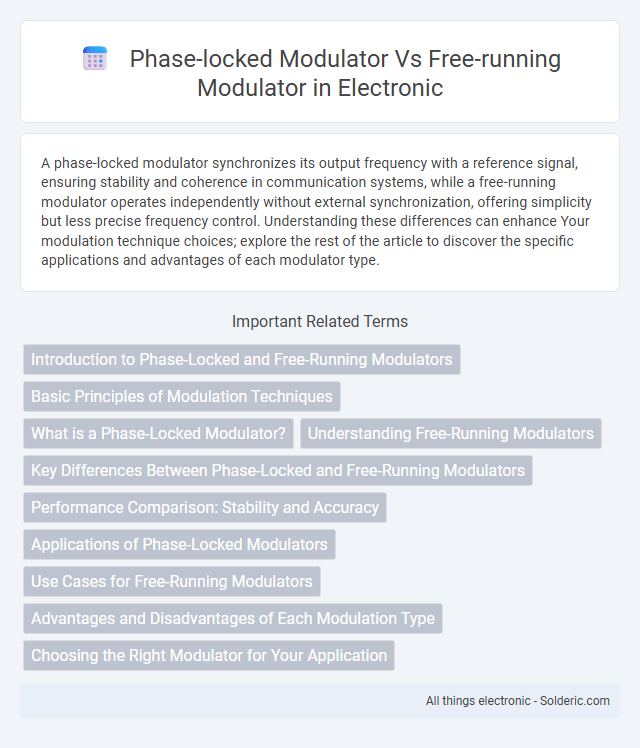A phase-locked modulator synchronizes its output frequency with a reference signal, ensuring stability and coherence in communication systems, while a free-running modulator operates independently without external synchronization, offering simplicity but less precise frequency control. Understanding these differences can enhance Your modulation technique choices; explore the rest of the article to discover the specific applications and advantages of each modulator type.
Comparison Table
| Feature | Phase-Locked Modulator | Free-Running Modulator |
|---|---|---|
| Frequency Stability | High - locked to reference signal | Low - varies with conditions |
| Phase Noise | Low phase noise due to synchronization | Higher phase noise |
| Applications | Communication systems, radar, precise signal generation | Simple oscillators, cost-sensitive applications |
| Complexity | Higher - requires phase-locked loop circuitry | Lower - standalone operation |
| Power Consumption | Higher due to additional circuitry | Lower power usage |
| Tuning Capability | Excellent frequency control and tuning | Limited tuning accuracy |
| Output Signal Quality | Stable, clean output signal | Less stable, more signal variation |
Introduction to Phase-Locked and Free-Running Modulators
Phase-locked modulators synchronize the output frequency with a reference signal, minimizing phase noise and ensuring stable frequency control crucial in communications and radar systems. Free-running modulators operate independently without feedback, offering simpler design but prone to frequency drift and phase instability over time. The precise control in phase-locked modulators makes them ideal for applications requiring high spectral purity and phase coherence.
Basic Principles of Modulation Techniques
Phase-locked modulators rely on a feedback loop to synchronize the output signal phase with a reference input, ensuring stable and precise frequency modulation ideal for communication systems requiring accuracy. Free-running modulators operate independently without external phase synchronization, often resulting in frequency drift and phase noise but allowing simpler circuit designs. Your choice between these modulation techniques depends on the required modulation stability and complexity of implementation in your specific application.
What is a Phase-Locked Modulator?
A Phase-Locked Modulator synchronizes its output signal phase with a reference input signal by using a phase-locked loop (PLL), ensuring stable and precise frequency modulation. It minimizes phase noise and frequency drift compared to free-running modulators, which operate independently without phase synchronization. The use of phase locking enhances modulation accuracy in communication systems and radar applications.
Understanding Free-Running Modulators
Free-running modulators operate independently without synchronization to an external reference signal, resulting in potential frequency drift and phase noise. Unlike phase-locked modulators, free-running types are simpler and less costly but may introduce signal instability affecting your communication system's performance. Understanding their characteristics is crucial for applications where precise frequency control and low phase noise are essential.
Key Differences Between Phase-Locked and Free-Running Modulators
Phase-locked modulators maintain synchronization with a reference signal, ensuring stable phase and frequency, which enhances signal coherence and reduces phase noise. Free-running modulators operate without external synchronization, leading to potential frequency drift and increased phase noise that can degrade signal quality. The key difference lies in phase stability, with phase-locked modulators offering precise control ideal for communication systems requiring minimal signal distortion.
Performance Comparison: Stability and Accuracy
Phase-locked modulators maintain high stability and accuracy by continuously synchronizing with a reference signal, reducing phase noise and frequency drift compared to free-running modulators. Free-running modulators exhibit greater frequency variability and phase instability due to the absence of a synchronization mechanism, which can degrade signal quality in precision applications. Your choice should prioritize phase-locked modulators when consistent performance and minimal signal distortion are critical.
Applications of Phase-Locked Modulators
Phase-locked modulators are extensively used in communication systems requiring stable frequency and phase coherence, such as phase-locked loops (PLLs) in radar and satellite communication. These modulators enhance signal integrity by synchronizing the carrier phase with an external reference, minimizing phase noise and jitter in digital data transmission. Applications also span frequency synthesis and coherent demodulation, where precise phase alignment is critical for accurate signal recovery and modulation accuracy.
Use Cases for Free-Running Modulators
Free-running modulators are widely used in applications where simplicity and low cost are essential, such as in basic signal transmission for radio broadcasting and simple communication systems. They provide stable frequency modulation without the need for an external reference signal, making them ideal for standby and backup modulation systems in satellite communications and low-power wireless devices. Free-running modulators also serve well in experimental setups where ease of adjustment and quick frequency variation are required, such as in test equipment and educational laboratories.
Advantages and Disadvantages of Each Modulation Type
Phase-locked modulators provide stable frequency control and improved signal integrity by synchronizing with a reference signal, reducing phase noise and jitter, which is advantageous in communication systems requiring precision. However, they tend to have higher complexity, increased power consumption, and greater implementation cost compared to free-running modulators. Free-running modulators offer simplicity, lower cost, and faster response times but suffer from frequency drift and lower spectral purity, making them less suitable for high-accuracy or long-distance transmission.
Choosing the Right Modulator for Your Application
Choosing the right modulator depends on stability and signal purity; phase-locked modulators provide precise frequency control and reduced phase noise, ideal for high-performance communication systems. Free-running modulators offer simpler design and lower cost but may suffer from frequency drift, making them suitable for less critical applications. Evaluating the trade-offs between frequency stability and complexity ensures optimal modulator selection for specific project requirements.
Phase-locked modulator vs free-running modulator Infographic

 solderic.com
solderic.com